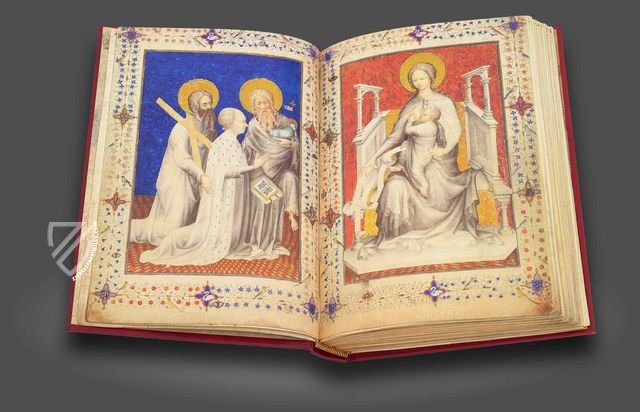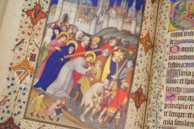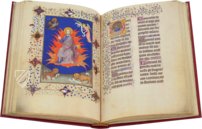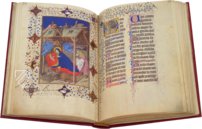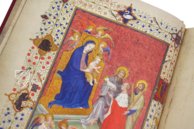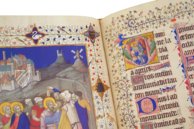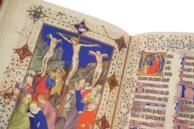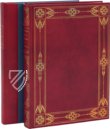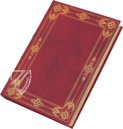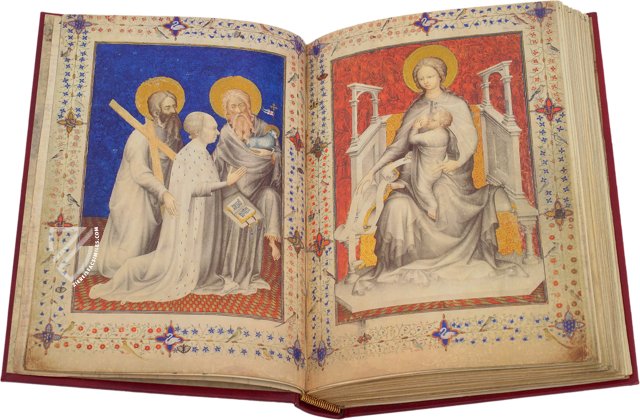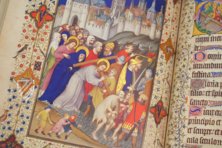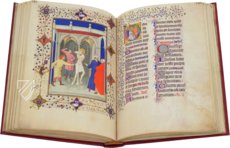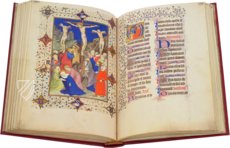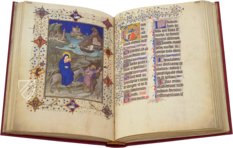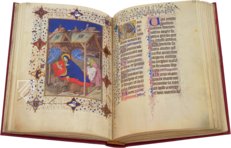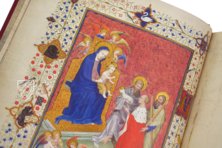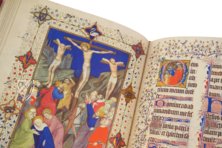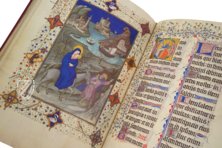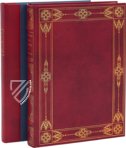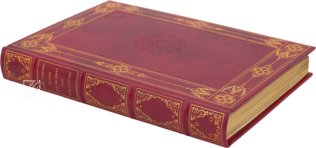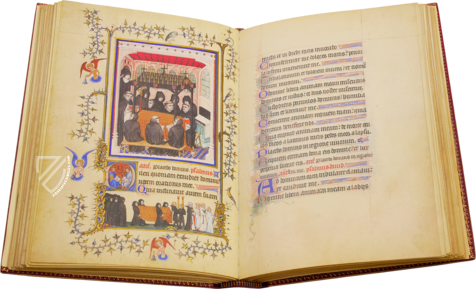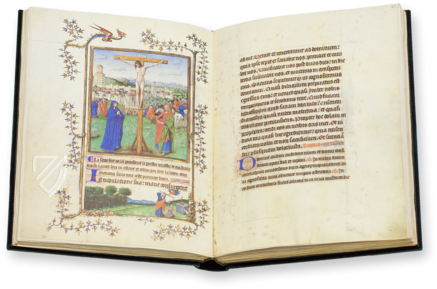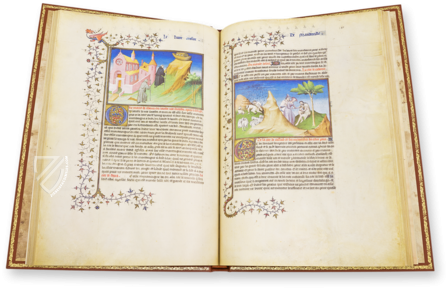Brussels Hours
(1,000€ - 3,000€)
The Brussels Hours is an illuminated manuscript that played an outstanding role in medieval French illumination. It originated ca. 1400 and neither a patron nor a maker of the masterpiece can be conclusively determined to this day. An illustrative technique, which was previously only used in panel painting, was employed in this private prayer book for the first time. In this way, the dreamlike pictures of the manuscript gained a significance that made the miniatures into small, independent works of art. Without text, the depictions also develop an intangible effect. The manuscript ensured a revolution of French manuscript and illumination art.
Brussels Hours
The mysterious Brussels Hours is not only noteworthy because of its artful, unbelievably high-quality illumination. It is simultaneously a codex whose origin story cannot be fully explained to this day. The private prayer and devotional book originating from ca. 1400 is comprised of 276 pages with 20 stunning full-page miniatures. A particularly enchanting characteristic of the manuscript is the recurring depiction of a wounded swan, interpreted by experts as a sign of the memory of a great, painful love. The pictures were produced using a particularly technical process in their form and execution and do not correspond to the typical book illustrations of their time. The Brussels Hours is a work of truly groundbreaking and modern style.
The Mysterious Origin of the Codex
The patron of the Brussels Hours cannot be determined with certainty to this day. However, evidence suggests that it could be Jean de Valois, Duke of Berry. Depictions of the ducal escutcheon, ducal emblems, and the monogram “VE” in the illuminated manuscript clearly support this thesis. A lively discussion concerning the composer of the masterpiece also exists among modern researchers. André Beauneveu, a sculptor and painter from Hainaut, has been considered as a possible master of the book. Beauneveu became famous for his works for the French court, in particular for an introductory miniature in the Duke of Berry’s famous psalter. The artist is equally responsible for an entire series of imposing tomb statues for the Abbey of St. Denis. The conception and preliminary drawings of the miniatures could also possible be traced back to the illuminator Jacquemart, who was in the service of the Duke of Berry since 1384. In any case, the Brussels Hours were made by a master who revolutionized the craft of illuminated manuscripts.
Modern and Groundbreaking Illumination
The illumination of the Brussels Hours boasts a few special characteristics, which arise for the first time in the history of the manuscript book art of the Middle Ages. The undetermined master of the book of hours used a method of coloration that had previously appeared exclusively in panel painting. This is the so-called demi-grisaille technique. Grisaille indicates a type of painting which is done exclusively in grey, white, and black. In the demi-grisaille, the monochromatic coloration is enriched with powerfully luminous dashes of color. A unique play of light and volume is created through this original artistic method, which really comes into its own in a double-page illustration in the Brussels Hours. The book made an additional key innovation of book illustration acceptable. The miniatures of the manuscript fill entire pages, which was never the case previously, and affect the beholder like a window into illustrated scenery. Consequently, the miniature was lent an autonomous status for the first time, in which the impact of the picture unfolded completely free of accompanying text. This manner of illumination was a groundbreaking innovation for French illumination in the Middle Ages, which makes the Brussels Hours the source of Gothic illumination.
Codicology
- Alternative Titles
- Brüsseler Stundenbuch
- Size / Format
- 276 pages / 27.5 × 18.5 cm
- Origin
- France
- Date
- Ca. 1400
- Epochs
- Style
- Genre
- Language
- Illustrations
- 20 full-page miniatures (including the famous double-page with the portrait of Jean, Duc de Berry in demi-grisaille technique) and 17 marvellous initial pages with partial ornamental borders
- Patron
- Probably Jean, Duc de Berry (1340–1416)
- Artist / School
- André Beauneveu
Jacquemart de Hesdin
Brussels Hours
Christ Carrying the Cross
Burdened by the weight of his cross, we see Christ on the road to Golgotha, also known as Calvary, and followed immediately by his mother, who holds her hand up to her face in horror and despair. Mary Magdalene, dressed in red, comforts the Virgin Mary with a hand on her shoulder. With their hands bound, the two thieves who are to be crucified with Jesus are drawn along by soldiers. Each individual in the throng of people has a unique and expressive countenance on their face.
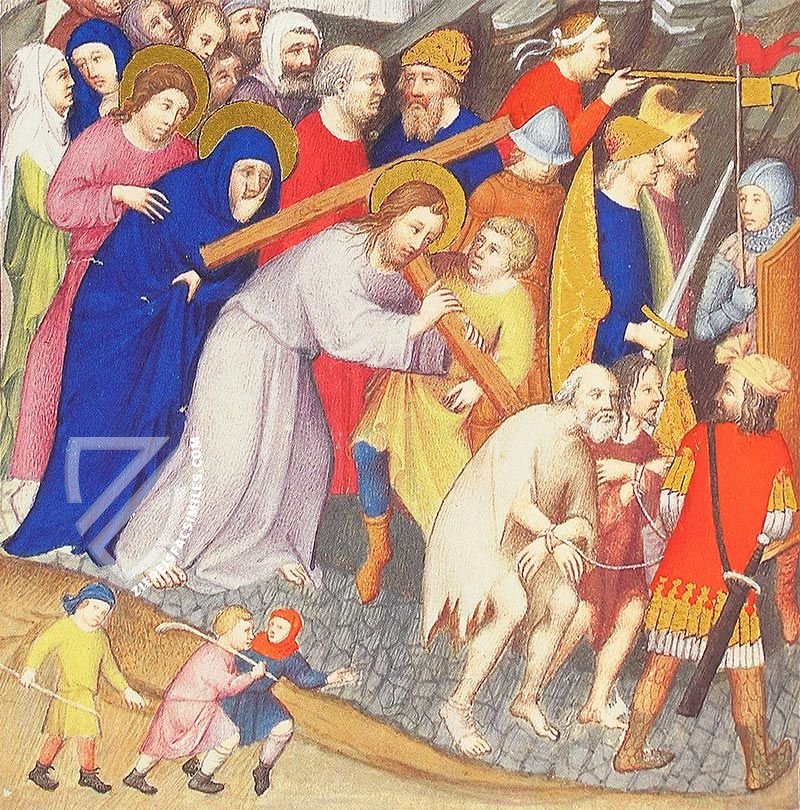
Brussels Hours
Portrait of the Duke of Berry in Prayer
This miniature and the Madonna and Child that appears opposite of it are milestones of illumination. The so-called demi-grisaille technique, previously reserved for panel painting, was employed in an illuminated manuscript for the first time here. Although it cannot be said for certain, numerous symbols indicate that the figure praying is Jean Duc de Berry, the greatest bibliophile of the Middle Ages.
The grisaille technique, which is limited to gray, white, and black, is elaborated here with luminous colors. A sense of perspective is created by the red/white checkered floor, while the sumptuous blue background seems to suspend space and time. In another first, the miniatures are presented entirely without text, allowing them to speak for themselves.
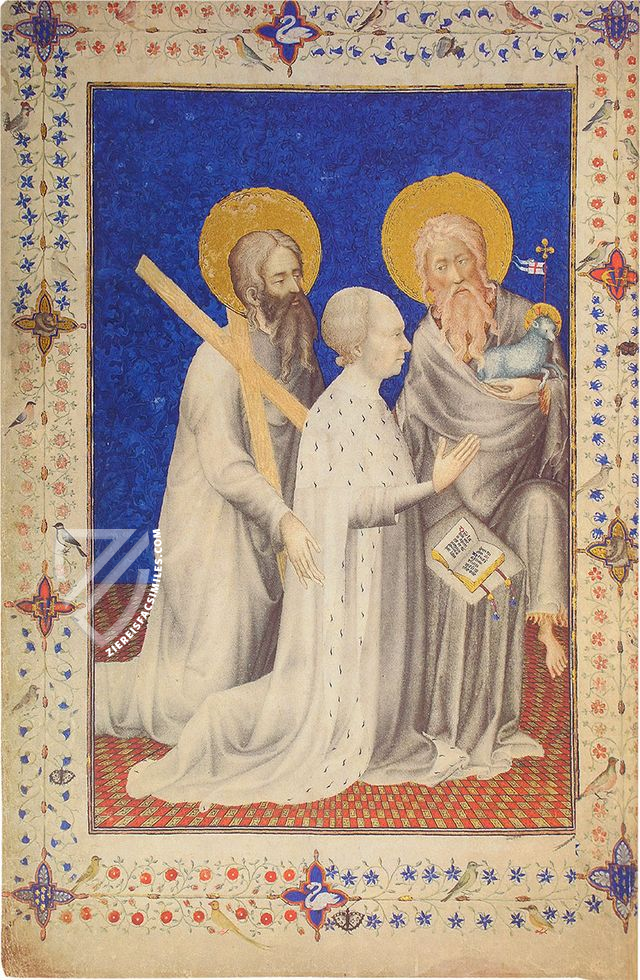
#1 Brüsseler Stundenbuch
Languages: French, German
(1,000€ - 3,000€)
- Treatises / Secular Books
- Apocalypses / Beatus
- Astronomy / Astrology
- Bestiaries
- Bibles / Gospels
- Chronicles / History / Law
- Geography / Maps
- Saints' Lives
- Islam / Oriental
- Judaism / Hebrew
- Single Leaf Collections
- Leonardo da Vinci
- Literature / Poetry
- Liturgical Manuscripts
- Medicine / Botany / Alchemy
- Music
- Mythology / Prophecies
- Psalters
- Other Religious Books
- Games / Hunting
- Private Devotion Books
- Other Genres
- Afghanistan
- Armenia
- Austria
- Belgium
- Colombia
- Croatia
- Cyprus
- Czech Republic
- Denmark
- Egypt
- Ethiopia
- France
- Germany
- Greece
- Hungary
- India
- Iran
- Iraq
- Israel
- Italy
- Japan
- Lebanon
- Luxembourg
- Mexico
- Morocco
- Netherlands
- Palestine
- Peru
- Poland
- Portugal
- Russia
- Serbia
- Spain
- Sri Lanka
- Sweden
- Switzerland
- Syria
- Turkey
- Ukraine
- United Kingdom
- United States
- Uzbekistan
- Aboca Museum
- Ajuntament de Valencia
- Akademie Verlag
- Akademische Druck- u. Verlagsanstalt (ADEVA)
- Aldo Ausilio Editore - Bottega d’Erasmo
- Alecto Historical Editions
- Alkuin Verlag
- Almqvist & Wiksell
- Amilcare Pizzi
- Andreas & Andreas Verlagsbuchhandlung
- Archa 90
- Archiv Verlag
- Archivi Edizioni
- Arnold Verlag
- ARS
- Ars Magna
- ArtCodex
- AyN Ediciones
- Azimuth Editions
- Badenia Verlag
- Bärenreiter-Verlag
- Belser Verlag
- Belser Verlag / WK Wertkontor
- Benziger Verlag
- Bernardinum Wydawnictwo
- BiblioGemma
- Biblioteca Apostolica Vaticana (Vaticanstadt, Vaticanstadt)
- Bibliotheca Palatina Faksimile Verlag
- Bibliotheca Rara
- Boydell & Brewer
- Bramante Edizioni
- Bredius Genootschap
- Brepols Publishers
- British Library
- C. Weckesser
- Caixa Catalunya
- Canesi
- CAPSA, Ars Scriptoria
- Caratzas Brothers, Publishers
- Carus Verlag
- Casamassima Libri
- Chavane Verlag
- Christian Brandstätter Verlag
- Circulo Cientifico
- Club Bibliófilo Versol
- Club du Livre
- CM Editores
- Collegium Graphicum
- Collezione Apocrifa Da Vinci
- Comissão Nacional para as Comemorações dos Descobrimentos Portugueses
- Coron Verlag
- Corvina
- CTHS
- D. S. Brewer
- Damon
- De Agostini/UTET
- De Nederlandsche Boekhandel
- De Schutter
- Deuschle & Stemmle
- Deutscher Verlag für Kunstwissenschaft
- DIAMM
- Droz
- E. Schreiber Graphische Kunstanstalten
- Ediciones Boreal
- Ediciones Grial
- Ediclube
- Edições Inapa
- Edilan
- Editalia
- Edition Deuschle
- Edition Georg Popp
- Edition Leipzig
- Edition Libri Illustri
- Editiones Reales Sitios S. L.
- Éditions de l'Oiseau Lyre
- Editions Medicina Rara
- Editorial Casariego
- Editorial Mintzoa
- Editrice Antenore
- Editrice Velar
- Edizioni Edison
- Egeria, S.L.
- Eikon Editores
- Electa
- Emery Walker Limited
- Enciclopèdia Catalana
- Eos-Verlag
- Ephesus Publishing
- Ernst Battenberg
- Eugrammia Press
- Extraordinary Editions
- Fackelverlag
- Facsimila Art & Edition
- Facsimile Editions Ltd.
- Facsimilia Art & Edition Ebert KG
- Faksimile Verlag
- Feuermann Verlag
- Folger Shakespeare Library
- Franco Cosimo Panini Editore
- Friedrich Wittig Verlag
- Fundación Hullera Vasco-Leonesa
- G. Braziller
- Gabriele Mazzotta Editore
- Gebr. Mann Verlag
- Gesellschaft für graphische Industrie
- Getty Research Institute
- Giovanni Domenico de Rossi
- Giunti Editore
- Graffiti
- Grafica European Center of Fine Arts
- Guido Pressler
- Guillermo Blazquez
- Gustav Kiepenheuer
- H. N. Abrams
- Harrassowitz
- Helikon
- Hendrickson Publishers
- Henning Oppermann
- Herder Verlag
- Hes & De Graaf Publishers
- Hoepli
- Holbein-Verlag
- Hortus Deliciarum
- Houghton Library
- Hugo Schmidt Verlag
- Idion Verlag
- Il Bulino, edizioni d'arte
- ILte
- Imago
- Insel Verlag
- Instituto Nacional de Antropología e Historia
- Istituto dell'Enciclopedia Italiana - Treccani
- Istituto Ellenico di Studi Bizantini e Postbizantini
- Istituto Geografico De Agostini
- Istituto Poligrafico e Zecca dello Stato
- Italarte Art Establishments
- J. Thorbecke
- Jan Thorbecke Verlag
- Johnson Reprint Corporation
- Josef Stocker
- Josef Stocker-Schmid
- Jugoslavija
- Karl W. Hiersemann
- Kasper Straube
- Kaydeda Ediciones
- Kindler Verlag / Coron Verlag
- Kodansha International Ltd.
- Konrad Kölbl Verlag
- Kurt Wolff Verlag
- La Liberia dello Stato
- La Linea Editrice
- La Meta Editore
- Lambert Schneider
- Landeskreditbank Baden-Württemberg
- Leo S. Olschki
- Les Incunables
- Library of Congress
- Libreria Musicale Italiana
- Lichtdruck
- Lito Immagine Editore
- Lumen Artis
- Lund Humphries
- M. Moleiro Editor
- Maison des Sciences de l'homme et de la société de Poitiers
- Manuscriptum
- Martinus Nijhoff
- Maruzen-Yushodo Co. Ltd.
- MASA
- McGraw-Hill
- Militos
- Millennium Liber
- Müller & Schindler
- Nahar and Steimatzky
- National Library of Wales
- Neri Pozza
- Nova Charta
- Oceanum Verlag
- Odeon
- Orbis Mediaevalis
- Orbis Pictus
- Österreichische Staatsdruckerei
- Oxford University Press
- Pageant Books
- Parzellers Buchverlag
- Patrimonio Ediciones
- Pattloch Verlag
- PIAF
- Pieper Verlag
- Plon-Nourrit et cie
- Prestel Verlag
- Princeton University Press
- Prisma Verlag
- Priuli & Verlucca, editori
- Pro Sport Verlag
- Propyläen Verlag
- Pytheas Books
- Quaternio Verlag Luzern
- Reales Sitios
- Recht-Verlag
- Reichert Verlag
- Reichsdruckerei
- Riehn & Reusch
- Roberto Vattori Editore
- Rosenkilde and Bagger
- Roxburghe Club
- Salerno Editrice
- Sarajevo Svjetlost
- Schöck ArtPrint Kft.
- Scolar Press
- Scrinium
- Scripta Maneant
- Scriptorium
- Siloé, arte y bibliofilia
- SISMEL - Edizioni del Galluzzo
- Sociedad Mexicana de Antropología
- Société des Bibliophiles & Iconophiles de Belgique
- Soncin Publishing
- Sorli Ediciones
- Stainer and Bell
- Studer
- Styria Verlag
- Sumptibus Pragopress
- Szegedi Tudomànyegyetem
- Taberna Libraria
- Tarshish Books
- Taschen
- Tempus Libri
- Testimonio Compañía Editorial
- Thames and Hudson
- The Clear Vue Publishing Partnership Limited
- The Facsimile Codex
- The Folio Society
- The Marquess of Normanby
- The Richard III and Yorkist History Trust
- Tip.Le.Co
- TouchArt
- TREC Publishing House
- TRI Publishing Co.
- Trident Editore
- Typis Regiae Officinae Polygraphicae
- Union Verlag Berlin
- Universidad de Granada
- University of California Press
- University of Chicago Press
- Urs Graf
- Vallecchi
- Van Wijnen
- VCH, Acta Humaniora
- VDI Verlag
- VEB Deutscher Verlag für Musik
- Verlag Anton Pustet / Andreas Verlag
- Verlag Bibliophile Drucke Josef Stocker
- Verlag der Münchner Drucke
- Verlag für Regionalgeschichte
- Verlag Styria
- Vicent Garcia Editores
- W. Turnowsky
- Waanders Printers
- Wiener Mechitharisten-Congregation (Wien, Österreich)
- Wissenschaftliche Buchgesellschaft
- Wydawnictwo Dolnoslaskie
- Xuntanza Editorial
- Zakład Narodowy
- Zollikofer AG

